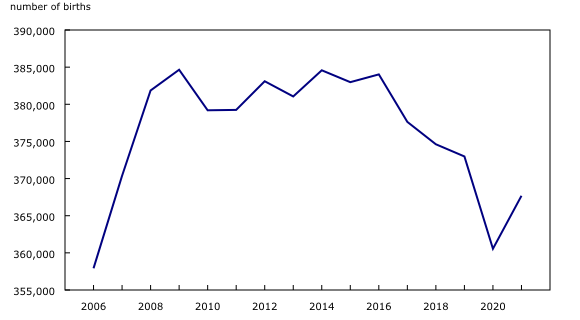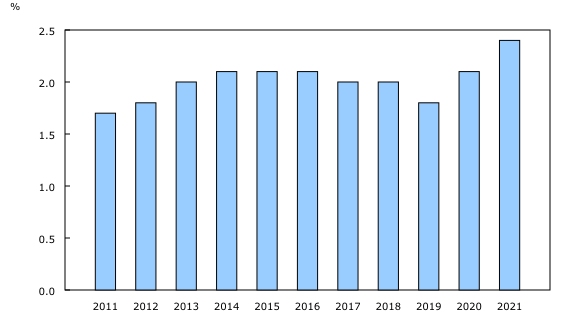Births, 2021
Released: 2022-09-28
In 2021, there were 367,684 live births in Canada, excluding Yukon. Similar to previous years, the proportion of boys (51.3%) was slightly higher than the proportion of girls (48.7%).
New preliminary information on 2021 births and stillbirths is available today from the Canadian Vital Statistics: Birth Database and the Canadian Vital Statistics: Stillbirth Database. Birth data from 1991 to 2020 have also been revised to reflect the latest data available. These data provide important insights into the continued effects of the COVID-19 pandemic on Canadian births.
Number of births in Canada start to rebound in 2021
The number of live births in Canada in 2021 was 367,684, up 2.0% from 2020 (360,552). This marked the first time that births increased year over year since 2016. Newfoundland and Labrador (+6.9%) and Prince Edward Island (+11.8%) had the biggest relative increases in births in 2021.
Historically, the number of births has declined by an average of 0.3% per year from 2011. The decrease was even more pronounced from 2019 to 2020, when births were down by 3.3%. This could be attributed to several factors, including reduced international migration and financial uncertainty many families experienced at the onset of the COVID-19 pandemic.
Immigration is important to sustain population growth and contribute to increasing the fertility rate in Canada. Immigration likely played a role in the decreased births in 2020 and the increase in 2021. Canada admitted 184,500 immigrants in 2020, roughly 45% fewer immigrants than in 2019. In contrast, the country welcomed 401,000 new permanent residents over the course of 2021, the most newcomers in any year in Canadian history. The availability of COVID-19 vaccines and families delaying pregnancies originally planned for 2020 are also possible factors in the uptick of births in 2021.
Despite the increase in 2021, births were 1.4% lower than pre-pandemic levels in 2019, when there were 372,978 births. This could be attributed in part to the impact that COVID-19 had on families' fertility plans. Among the individuals surveyed in 2021 for the Canadian Social Survey, nearly one in five (19%) reported that, because of the pandemic, they now want to have fewer children or have a baby later than previously planned.
Non-hospital births continue to increase in 2021
The pandemic disrupted health care around the world, including birthing practices. In fact, a larger proportion of births took place in non-hospital settings in Canada compared with recent years. Births that occurred in a home, a birthing centre or other facility accounted for 2.1% of all births in 2020, the highest proportion of non-hospital births in more than a decade.
Before this spike in 2020, pre-pandemic births occurring outside of a hospital were on the decline from 2015 to 2019. Uncertainty about the virus, restrictive hospital protocols and fears of going into a hospital where COVID-19 patients were being treated may have led more women to have babies outside of hospitals in the first year of the pandemic.
This trend continued into 2021, with even more families having a baby outside of a hospital in the second year of the pandemic. Non-hospital births made up 2.4% of all births in Canada in 2021; 8,831 babies were born outside of a hospital. The early months of 2021 had the biggest proportion of non-hospital births; 2.8% of all births in February 2021 were reported as having happened outside of a hospital setting. This followed a period when COVID-19 rates were elevated in Canada, which may have prompted some families to plan to give birth at home or at a non-hospital facility.
One quarter of mothers that gave birth in 2021 are aged 35 years and older
Women in Canada are having children later and later in life. The mean (average) age at which a mother gives birth in Canada has continued to increase over the last couple decades. In 2001, the mean age of mothers at time of delivery was 29 years old. In 2021, 20 years later, the mean age at the time of delivery was 31 years old.
The proportion of mothers of advanced maternal age (35 years and older) is also increasing. In 2021, 25% of all mothers at childbirth were 35 years of age and older. This represents a notable difference over time, as 16% of mothers were 35 years of age and older when giving birth in 2001. Research shows that women aged 35 years and older, particularly 40 years and older, may face an increased risk of fetal and maternal complications, such as stillbirth, chromosomal abnormalities, pre-gestational diabetes, and hypertensive diseases.
Note to readers
For 2021, in an effort to be timelier, the duration of data collection has been shortened compared with previous years. The 2021 data are therefore considered preliminary. Data for births from 1991 to 2020 have been revised, and 2021 data will be revised with subsequent releases.
Preliminary birth and stillbirth counts are based on what is reported to Statistics Canada by provincial and territorial vital statistics registries.
Data for 2017, 2018, 2019, 2020 and 2021 births and stillbirths occurring in Yukon are not available. To avoid confusion, data for these same years for births and stillbirths to residents of Yukon that occurred in other provinces and territories were also suppressed.
As a result of delays with birth registrations, fewer births have been captured to date for Manitoba in 2021. There were also fewer births captured for Nova Scotia in 2021 due to coverage issues.
Immigration numbers come from Immigration, Refugees and Citizenship Canada news release (2021).
Figures on fertility intentions come from the Canadian Social Survey – COVID-19 and Wellbeing.
Risk factors associated with advanced maternal age are from the Public Health Agency of Canada's Family-Centred Maternity and Newborn Care: National Guidelines.
Further information on fertility rates is available in tables 13-10-0417-01 and 13-10-0418-01 and in Fertility indicators, provinces and territories: Interactive dashboard.
Contact information
For more information, or to enquire about the concepts, methods or data quality of this release, contact us (toll-free 1-800-263-1136; 514-283-8300; infostats@statcan.gc.ca) or Media Relations (statcan.mediahotline-ligneinfomedias.statcan@statcan.gc.ca).
- Date modified:


